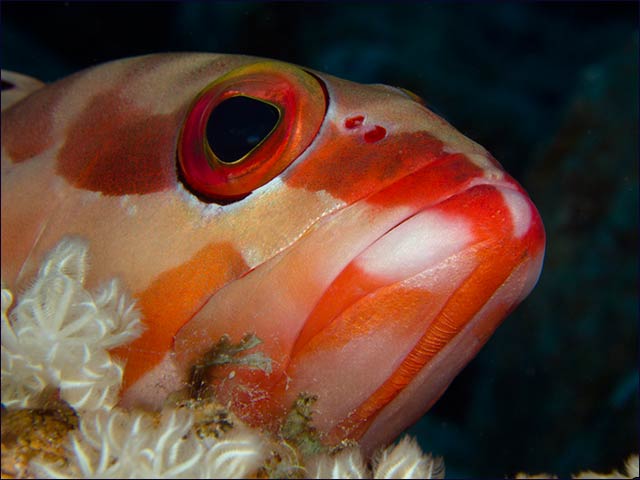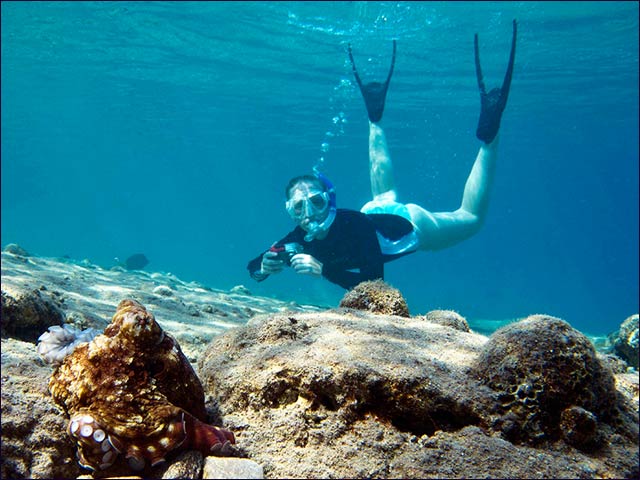By Sarah Carnvek
The resort town of Eilat in Israel has long been a diving paradise. With easy shore access to beautiful coral reefs, colorful fish and fascinating wrecks, a wide range of accommodations and reliable weather every day of the year – diving enthusiasts have made the pilgrimage here for decades.
The Gulf of Aqaba – with coastlines along Israel, Saudi Arabia, Egypt and Jordan – is world-famous for its marine biodiversity and corals. And the Red Sea coral reefs are the northernmost tropical coral reefs in the world.
There are hundreds of types of coral and some 800 varieties of sea life in the Red Sea including octopi, stingrays, dolphins, barracudas, groupers, sea snakes, turtles, parrotfish, angelfish, butterfly fish, the most amazing sea slugs and sometimes whale sharks.
Eilat is famous for its multicolored underwater slugs, otherwise known as nudibranches.
"Slugs are more colorful underwater, and that’s the attraction. On land, they're brown or black and disgusting-looking, but underwater they have vibrant colors and a lot of divers fall in love with them," says Shulamit Koretz who, together with her husband Binyamin, is an Israeli expert on sea slugs.
"Eilat is a great destination for diving. There are a lot of different dive sites, but you have to know where to go," says Koretz, a Professional Association of Diving Instructors master scuba-diving trainer.
"The Red Sea is renowned for its variety of fish species and invertebrates. There are also two wrecks that attract a lot of sea life."
Those two wreck sites are the Satil and the Yatush. The Satil is one of the best-known diving spots in Israel. The 45-meter-long Israeli missile ship was sunk purposely in 1994 to bring fish and divers – from beginners to experienced -- to the area. The Yatush wreck, on the other hand, is only for experienced divers. It is a United States vessel that was sunk to a depth of 32 meters. It, too, draws a variety of underwater sea life.
There are also gorgeous and accessible coral reefs. In fact, for good and for bad, the coral reefs just off Eilat's coast are among the most heavily used in the world for recreational diving, with 250,000 to 300,000 dives per year on only 7.5 miles (12 kilometers) of coastline.

Many colorful fish live in the Eilat waters. Photo by Shai Oron/Interuniversity Institute for Marine Sciences Restoring coral reefs
Like other popular diving sites, the heavy swim traffic around Eilat's coral reefs sent them into decline over the past four decades. This triggered warnings by marine biologists that if something wasn’t done, the damage would be irreversible.
Though there will always be some ignorant people who try to snap off pieces of coral as a souvenir to take home, leading marine biologist Nadav Shashar says that for the most part divers are environmentally conscientious.
"Divers want to dive responsibly. When they damage a reef, it's by mistake. It happens," says Shashar, a senior lecturer in life sciences at Ben-Gurion University's Eilat campus. "You just have to find a way of repairing damages."
Israel came up with plans of action, and today Eilat's dive sites are said to be in better shape than they were a decade ago.
"[Eilat is] one of the best places for a leisure dive," writes Canada's Reefcrazy on the popular TripAdvisor site.
Koretz, who runs a diving center in Eilat, says the Coral Beach Marine Reserve helped get the Red Sea reefs back on track. The reserve is a protected area surrounding a 1,200-meter (3937 feet)-long reef. Visitor numbers are restricted and, while divers are invited to observe life on the coral reef, they are kept far enough away to keep this delicate ecosystem thriving.
Shashar points to the Dekel Beach reef restoration project and the Tamar reef as other successes.
At Dekel, Israeli scientists harvested coral nubbins and transplanted them in degraded reefs. "Today you can't tell what's real and what we planted," Shashar says.
The Tamar artificial reef is another popular diving site. It was built by Shashar and other researchers to promote marine life.
" Shashar and his team came up with the idea to create an artificial reef and take the traffic off the natural reef. I think that's a pretty savvy idea," says marine geo-archaeologist Beverly Goodman Tchernov of the Charney School of Marine Sciences at the University of Haifa.

You might see one of these creatures underwater. Photo by Shai Oron/Interuniversity Institute for Marine Sciences"The Tamar reef is very active and is flourishing," says Shashar, who has logged more than 2,000 dives. "It's not big– only four meters by four meters. It looks like, and will always look like, an artificial reef. There are more fish than in a comparable reef. It’s for training divers. It's easy for them to train without damaging the reef. It's a good place to practice."
And that is the key to diving responsibly – training in a safe spot and only then swimming near natural coral reefs.
"One of the best ways a diver can dive responsibly is to practice diving skills in places that do not have coral around them. All it takes is one 'oops' where you knock into something and you just caused damage that can take years or longer to repair," says Goodman Tchernov.
That said, Goodman Tchernov still promotes diving as an environmentally friendly sport. She says that people dive because of their love for the underwater world. And, she stresses, once someone knows what is below the ocean's surface, that person will likely do all he or she can to protect it.
"Going out and seeing the natural world with your own eyes is an environmental thing to do, and hopefully people who are diving responsibly will become stakeholders in the future of the reef," says Goodman Tchernov.
"There's nothing like witnessing it yourself to become attached to it. You want people to see it and experience it, but also to be careful."
Beginners to experts
Just about every beach in Eilat offers diving gear for rent. Diving represents 10 percent of the tourism income to the country's southern city, according to the Israel Ministry of Tourism.
With water temperatures around 21 to 25 degrees Celsius (70 to 77 degrees Fahrenheit), little or no currents and clear waters with an average 20 to 30 meters (65 to 100 feet) of visibility, there's a reason tourists return time and again.
Eilat's shores are packed with diving sites for every level. There are also dozens of certified diving schools and snorkeling outfits.

Red Sea diving. Photo by Shai Oron/Interuniversity
Institute for Marine Sciences"People come from all over Europe, from the US and Canada, and a lot fromSouth America," says Koretz, whose diving school continuously ranks high with TripAdvisor users.
"Most have dived all over the world and come to Eilat as part of a bigger trip to Israel. The tourists from Finland, however, come in winter just to escape the cold."
The best-known dive spots include the Japanese Gardens, close to the Coral World Underwater Observatory and a favorite spot to see schools of fish and corals; the Dolphin Reef, where you can dive and swim with dolphins; and the Caves, 500 meters north of the border with Egypt, with two underwater passages and hundreds of fish called sweepers.
The Japanese Gardens are among the best protected diving sites in Eilat and extend over an area of 500 meters. There are two diving options here. There's a deep dive down a gorgeous coral slope to the depths of the Red Sea. Then there's a shallow dive, passing one of the most amazing parts of the reef.
The Coral Beach Nature Reserve, one of Koretz's favorite dive spots, is home to one of the most densely populated coral reefs in the world. It serves up a gorgeous scene of colorful tropical fish, strange but beautiful corals, and giant shells.
Koretz, who has logged well over 7,000 dives, also recommends Neptune's Tables, where old tables of Acropora corals ranging between 15 to 40 meters (49 to 131 feet) in depth house varieties of fish and other aquatic life.
The Eel Garden, 100 meters (328 feet) north of the Coral Reef fence, is a diving spot usually overlooked but worth a quick visit. The way the water flows here triggers the usually shy eels to congregate and thus offers an unexpected sight for the diving community.
Koretz says she drives home the message of safety under the water, whether she's teaching new divers or veterans. "I always tell divers there are living creatures down there and we need to be careful," she says.
Goodman Tchernov says respecting nature and keeping a distance will reward divers in the long run. "Stay one-two meters away from reef; you don't need to be right next to it to see what's happening," she says. "In nature, if you slow down and take your time, the animals will approach you. It's to your advantage to go slow."
Goodman Tchernov, who has been recognized by National Geographic as an Ocean Hero, says people can "definitely dive responsibly and not hurt the environment doing so."